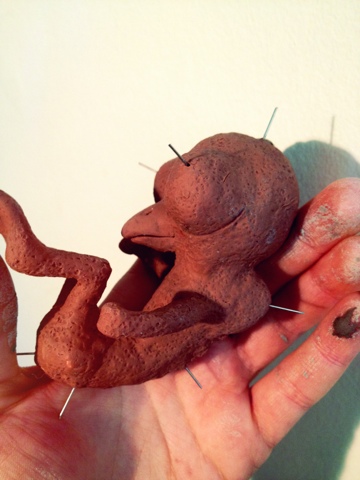Since there is a large undercut in the sculpt, the mould needs to be in silicone, which is flexible, a fiberglass mould would make the core get stuck in the mould and ruin the foetus.
The first layer of moulding silicone is brushed on as a thin layer, covering the whole sculpt and clay wall, this will pick upp all of the detail, and it also helps to avoid air traps. It looks like melted strawberry ice cream, but you should definitely not eat it.
Once the first layer is tacky, but not completely set it is time for the next layer of silicone. To test this you can put your finger on the surface after about 15 min, it should leave a fingerprint on the silicone without still being wet, if it starts to let go of the sculpt, it is to dry and the second layer will be hard to apply.
The second layer has thixotropic mixed into it, which makes it thicken up to a more buttery consistency. Use a paintbrush or a wooden mixing stick to apply the silicone evenly across the first layer.
Leave it to set for at least an hour, it is important for the silicone to be completely set before fiberglassing. Also remember that different silicones has different abilities, and you need to test it first to know how fast it sets etc. Once it is set you can remove the clay wall surrounding it, trimming it down to the same level as the silicone. On top of the silicone I need to make a fiberglass jacket, that will hold the silicone in place.
Cut away a few wedges around the edge for the fiberglass to snap on to.
Then it is time for fiberglassing, remember to wear protective clothing since the fumes can severely harm your breathing organs longterm. You need to wear a respirator that protects you from organic vapors, glasses, an overall or other protective clothing. You will also need a pack of latex gloves, since you are going to need to change a few times during the process.
The first layer is the Gel coat, it picks upp all lof the details and creates the base for the mould. Is is a thick, slightly pink transparent gel that you mix with 2-6 percent catalyst. 2 percent is recommended, if you over catalise it it will crack, but if the room is very cold it can be a good idea to add some extra catalyst into it, since you will have to wait forever to make the second layer else way.
Cover the whole surface with a layer of about 1 cm gel coat with a paint brush, leave it to set and clean out the brush with aceton immediately.
After about 20 minutes, the gel coat should be tacky, feel it with a gloved finger. Once it is tacky you sprinkle loose fiberglass on top of it, this wil the make the gel coat stick to the fiberglass matt.
Wait about another 10-15 minutes, until the gel coat is set. Then you start to apply the fiberglass matts with resin. The resin is mixed with one percent catalyst by weight, and it is very important not to over catalyse since it might get to hot and start to burn. Paint the fiberglass matt onto the gel coat with resin and a pint brush, the resin dissolves the fiberglass matts and they will create one smooth surface. Finish the procedure with adding a thin fiber glass cloth on top, that will make it smooth and less itchy.
Leave the fiberglass to set for about 20 minutes, once it starts to get a bit green to its color, you can trim the edge with a scalpel like cutting cardboard, but don't wait to long since once it is set you will need to trim it with a power saw.
Leave it to set properly for about an hour.
Then you can turn the mould over and remove the clay wall, be careful not to harm the sculpt. You will probably need to do some minor repairs to the back of the sculpt since it will probably be a little bit damaged no matter how careful you are.
Put up a new clay wall around the edge of the silicone, and sculpt in wedges matching the ones you made on the other half.
Then you repeat the whole process on the other half, and wait for the second half to set properly, the whole process took me two days, with a lot of waiting in between, so it is a good idea to be working on something else parallel.






















































